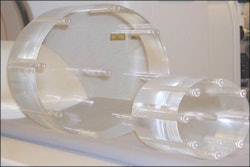While it's great to focus on reducing the radiation dose that patients receive from individual CT scans, radiologists shouldn't overlook the need to monitor cumulative dose in patients who are scanned multiple times, according to researchers from Pennsylvania.
In research presented at the recent American Roentgen Ray Society (ARRS) meeting in Vancouver, a group from Penn State Hershey Medical Center described their efforts to identify which patients are getting the most CT scans -- and, thus, the highest radiation dose.
They found that some patients received more than 300 mSv of cumulative radiation in a year, and one pediatric patient was scanned some 70 times.
Why cumulative dose is important
Government and industry are increasingly focused on how to decrease dose for single CT exams, but fewer researchers are examining cumulative dose and how to decrease the overall number of CT scans,according to the researchers.
Dr. Alexis Smith and colleagues investigated the number of repeated CT exams performed on patients at Hershey Medical Center to assess the cumulative radiation dose to this population. Although the numbers of patients receiving more than 20 exams per year is small, the fact remains that these patients are getting dangerous doses of radiation, Smith said.
"One of my attendings established a committee to monitor patient radiation dose, and this study came out of that," Smith told AuntMinnie.com. "We used our RIS to identify people who had had more than 20 exams in the time period, and found that a lot of them had high cumulative doses, more than 300 mSv in one year."
Are there baseline radiation exposure guidelines? Yes and no, according to Smith: The majority of long-term data on radiation exposure is from Japanese atomic bomb survivors who received much higher doses in a single exposure than patients receive with medical imaging; extrapolating these data to infer the effects of lower doses remains controversial. The prevailing theory supported by the recent Biological Effects of Ionizing Radiation (BEIR) VII report is that there is an increased risk of cancer with even the smallest doses of radiation, Smith said.
Smith's team conducted a retrospective review of all patients who underwent CT exams between July 2009 and June 2010. A total of 72,601 CT scans were performed on 24,953 patients during the specified time period; of these, 18,987 patients had three or fewer body part examinations. An additional 5,906 patients had more than three but fewer than 20 body part examinations. The team found 60 patients who had 20 or more CT images during the time period: 50 adults and 10 children.
Of these 60 people, 15 were trauma patients, 20 were oncology patients, 16 had surgical complications, five had shunted hydrocephalus, and four had other conditions, Smith told session attendees. Cumulative radiation dose was often higher for those being treated for conditions such as postsurgical complications, hydrocephalus, pancreatitis, or cancer.
Patients receiving multiple CT studies
|
||||||||||||||||||||||||
| Total number of patients with specified range of cumulative body part examinations from July 1, 2009, to June 30, 2010, (before bundling of abdomen and pelvis CPT codes). |
The 76% (18,987) of the total cohort who had three or fewer body part exams annually had a low estimated cumulative radiation dose of 21 mSv, Smith said. Even though only 0.2% of patients received significant radiation dose due to repetitive scans, dose levels were disturbing: The 50 adult patients received a range of 42 mSv to 310 mSv in the study time frame, while the 10 pediatric patients received a range of 40 mSv to 135 mSv.
And in some cases, the need for CT wasn't clear, Smith said. The five pediatric shunted hydrocephalus patients didn't show any changes over the course of the study time frame. One patient with hydrocephalus received 70 CT scans as part of routine monitoring -- and none of them indicated any problems, Smith told AuntMinnie.com.
"We need to re-educate our referring physicians [and] use alternative modalities," she said. "Some individuals are slipping through the cracks."
The American College of Radiology has published appropriateness criteria for CT radiation doses, but the criteria are limited in the area of follow-up imaging, according to Smith.
"We need to expand the criteria and monitor radiation exposure for this subset of patients," she told AuntMinnie.com.
Insurance companies are bound to begin monitoring radiation dose by contracting companies to estimate cumulative doses for patients, Smith cautioned.
"There could potentially be a scenario like 'This person has had too much radiation, so we aren't paying for any more scans,' " she said. "Radiologists need to take a look at this and get ahead of the curve, rather than waiting for the government or for industry to address the problem. We're not going to lose business -- we're going to gain respect."



















